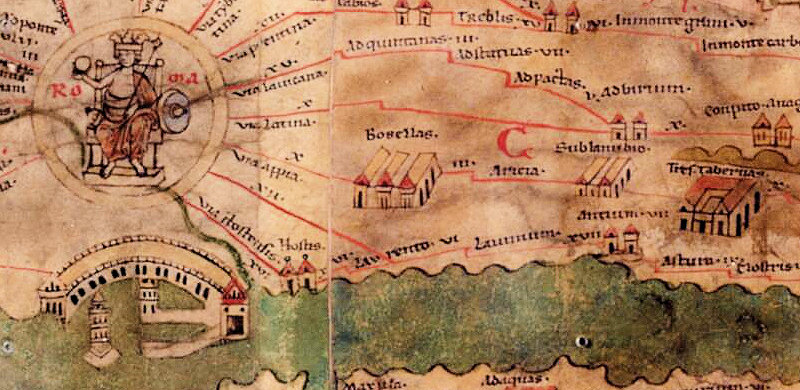THE ROAD FROM OSTIA TO PRATICA DI MARE (LAVINIUM)
The road between Ostia and Antium on the Tabula Peutingeriana.
Hostis - XVI - Laurento - VI - Lavinium - XVII - Antium. Image: omnesviae.org.
INTRODUCTION
In 1190 AD Richard the Lionheart stopped at Ostia, on his way to join the first crusade. Roger of Howden gives a detailed account. Richard's ship passed an area named after the lighthouse of Claudius: Le Far de Rume. He then entered the mouth of the Tiber and saw at the entrance a very beautiful but solitary tower. This must have been either what was left of the lighthouse of Claudius, if Richard entered the Fossa Traiana, or the small Tor Boacciana, if he entered the river itself. He saw immense ruins of ancient walls.
ROGER DE HOVEDEN - GESTA REGIS RICARDI
Praeteriit Cronet civitatem, et Senes la veile civitatem, et Laune civitatem, et locum dictum Le Far de Rume. Et postea intravit Tyberim, ad cuius introitum est turris pulcerrima sed solitaria. Et sunt ibi ruine maxime murorum antiquorum.Richard then entered into a financial argument with Octavianus, bishop of Ostia. The bishop wanted to invite him to visit the pope in Rome. Richard refused, accusing the church of the selling of ecclesiastical privileges to the highest bidder, and of asking large sums of money for appointments of people.
Illuc venit ad regem Octavianus Hostiensis episcopus, cui rex turpia multa dixit improbando Romanis simoniam, quod 700 marcas debuerant habere pro consecratione episcopi Cenomanensis et mille et 500 marcas pro legatione Eliensis episcopi et pecuniam magnam, ne deponeretur Burdegalensis, qui a clericis suis accusabatur de crimine. On the 26th day of August he sailed past a wood called Selvedeme, which is probably a corruption of 'Selva d'Enea', the forest of Aeneas. The mythical reference makes it clear that this is a road leading to the south, the area where Aeneas set foot on Italian soil. It was said to have been paved with marble and 80 miles long. The forest was full of deer, goats, and gazelles.
Vicesima sexta die Augusti transivit rex per quoddam nemus quod dicitur Selvedeme in quo est via marmorea ad modum pavimenti facta; et durat per medium nemus quater viginti miliaria. Nemus vero illud habundat cervis, capreolis et damulis. Richard then sailed past modern Anzio-Nettuno, to stop eventually in Naples.
Eodem die transivit per castellum quod dicitur Lettun. Hic est portus qui quondam tegebatur cupro et erat ibi introitus cripte per quam pecunia undique allata ferebatur Romam. On these pages we will follow Richard, through the forests, until Pratica di Mare.
In the past the area was explored especially by Carlo Fea, Antonio Nibby, Pietro Rosa and Rodolfo Lanciani. They charted the ruins and excavated several buildings. Research was started again by Gabriella Simonazzi Masarich, published in 1973. Then, in 1984, a new era of research and excavations began, as a combined Italian-British effort, led by Giuseppina Lauro and Amanda Claridge.
Carlo Fea (1753 - 1836)
Antonio Nibby (1792 - 1839)
Pietro Rosa (1810 - 1891)
Rodolfo Lanciani (1847 - 1929)
Amanda Claridge (1949 - 2022)
A note for archaeologists. The bibliography can be found at ostia-antica.org, menu option "Bibliography", keyword "Surroundings of Ostia - Laurentum". The pages that follow refer only incidentally to the primary sources and bibliography as an helpful anchor.
[Jan Theo Bakker, 2020]





